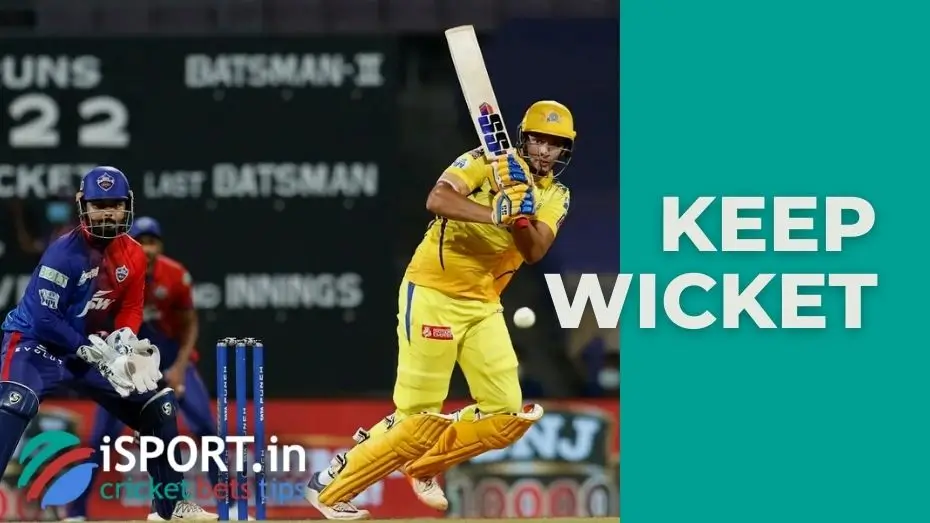Keep wicket

Keep wicket – a position behind the wicket, which is occupied by one of the players in the field team (wicket-keeper). His main task is to take the opponent’s batsman-striker out of the game. It can be done in several ways: intercept the bowler’s ball, destroy the wicket (stump), or force the opponent to step into touch. If the ball enters the outfield, the wicket-keeper can try to intercept it on the rebound.
Keep wicket has a separate section in the Cricket Rules (№ 40):
- The wicket-keeper is the only player allowed to wear gloves, additional leg protection, and a face mask. If the position and actions of the wicket-keeper indicate that he is not able to fulfill his duties, the judge has the right to remove him;
- Wicket-keeper gloves should not have unnecessary details – for example, jumpers between the fingers. The only exception is the webbing connecting the thumb and forefinger. The use of non-stretching material is allowed without additional reinforcement or folds. The outer edge of the tape should not protrude beyond the straight line formed by the tips of the index finger and thumb when the thumb is pulled to the side;
- The wicket-keeper’s position is strictly behind the wicket behind the striker, from the moment of service until the ball touches the bat or the batsman’s body (or crosses the wicket line or the striker tries to run). If this rule is violated, the referee should signal No ball as soon as possible;
- The regulations strictly limit the movements in the position of Keep wicket. If the wicket-keeper comes close to the wicket before the ball reaches the striker, the referee has the right to call Dead ball. However, if he is playing with a slow bowler, he can take a few steps forward;
- Keep wicket restrictions. A player playing in this position has no right to openly interfere with the striker from receiving the ball or defending the wicket. If his interference is evident, the referee has the power to invoke Rule 42.4 (Willful Attempt to Distract the Striker);
- Intervention by the Wicket-Keeper. Suppose the referee determines that the wicket goalkeeper was overtly interfering with the striker from defending the wicket or hitting at the time of service. In that case, no out will be awarded.
Even though Keep wicket is often underestimated, this position is not at all simple. The wicket-keeper must:
- Choose the right position. So, if he works in conjunction with a fast bowler, then the best option would be to sit a little further behind the wicket to have time to react to the change in the trajectory of the ball after contact with the batsman’s bat;
- Keep an eye on the ball at all times without losing contact with bowlers and other outfield players;
- Provide the captain with additional information about the shape of the enemy batsmen and their weaknesses, as well as suggest the most promising ways to withdraw from the game.
In the old days, the traditional Keep wicket position was a half-squat. Now they more often squat behind the wicket, following the example of Australian Sammy Carter. It is worth noting that playing in tandem with slow bowlers is somewhat easier than with fast bowlers since, in the latter case, you need a trained reaction and the ability to assess the angle of the ball quickly. Alec Bedser and Godfrey Evans (England) have been among one of the best combinations of fast bowler / wicket keeper in history.
Interestingly, previously, substitutes were not allowed to take the position of the wicket-keeper. True, exceptions occurred – for example, after the injury of the main wicket goalkeeper of the British, Bruce French, in a test match against New Zealand, the hosts successively replaced four players. However, the official permission to replace was spelled out only in the new edition of the Cricket Rules (2017).
At the same time, there are no strict restrictions on the Keep wicket position. Even though teams rarely refuse the services of a wicket-keeper, he can be transferred to the position of a fielder under certain circumstances.
The top ten wicket-keeper in test cricket competitions include:
Ranked Number Player Country Matches Cats Stumpy
1 Mark Boucher South Africa 147 532 23
2 Adam Gilchrist Australia 96 379 37
3 Ian Healy Australia 119 366 29
4 Rod Marsh Australia 96 343 12
5 Mahendra Singh Dhoni India 90 256 38
6 Brad Haddin Australia 66 262 8
7 Jeff Dujon West Indies 81 256 5
8 Alan Knott England 95 250 19
9 Bradley John Watling New Zealand 73 249 8
10 Matt Pryor England 79 243 13
It is interesting: the analogue of the wicket-keeper in baseball and softball is the catcher.
